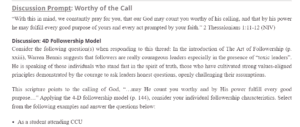4D Followership Model
Would you consider yourself, 1. A Disciple, 2. Doer, 3. Disengaged, or, 4. Disgruntled? Explain how you arrived at this conclusion and to what extent you find this model practical as a tool for analyzing the enigmatic majority. In your opinion, does such a model help in developing a more collaborative and innovative workplace?
The 4D Followership model describes interactions between followers and leaders in terms of behavior within a working environment. I believe that one can be more than one type of follower. For example, when a person starts a new project, he or she may be a disciple at first, entirely dedicated to the project and working to achieve the goal of the project. However, when there are delays, lapses, or repetitive tasks that either stagnate or decrease the speed of the project progression, such a person can become quietly frustrated with passively low motivation, a disengaged employee. Additionally, when a person genuinely loves their job but has an autocratic and unpleasant-to-work-with leader, such a person can become demotivated and a doer. When it comes to my role as a student at CCU, I oscillate between being a disciple and a doer. I chose to come to CCU because of its strong Christian foundation, and I believe it is by the leading of the only Spirit that I enrolled here. As a disciple follower, I am content with being a student at CCU and always look forward to learning and acquiring new knowledge as well as interacting with my peers. However, sometimes balancing work, home, and school becomes such a challenge that I end up a doer. I really enjoy the nature of my work and as it is, I am a disciple. I love to help the elderly and enrich their lives with the services I render to them. Interacting with them gives me a sense of satisfaction because I know I am fulfilling my purpose on earth.
The 4D followership model is practical only to a certain degree when it comes to analyzing employees in the workplace. This is because an employee does not remain in the same status of followership, and other factors within an organization can either enhance or minimize the level of followership. Thus, it calls for managers to be diligent in assessing the level of employee commitment to ensure that employees remain motivated and committed. Rodger Adair designed a tool that used the 4Ds and created an interplay of Turnover, High Productivity, and Job satisfaction factors. The tool is more comprehensive in determining the level of followership a person is at and what leaders can do to steer employees in the right direction to becoming disciples.
References
Adair R. (2016) 4D Followership Assessment Report. https://followership2.pbworks.com/f/Rodger+Adair+4-D+Followership+Report+Redesigned.pdf
List Bennis, W. (1990). Managing the dream: Leadership in the 21st century. Training: The magazine of human resource development, 27(5), 44-46.
The Gideons International in the British Isles. (2012). The Holy Bible: new international version. The Holy Bible: new international version. Lutterworth, England.
ORDER A PLAGIARISM-FREE PAPER HERE
We’ll write everything from scratch
Question
Discussion Prompt: Worthy of the Call
“With this in mind, we constantly pray for you, that our God may count you worthy of his calling, and that by his power he may fulfill every good purpose of yours and every act prompted by your faith.” 2 Thessalonians 1:11-12 (NIV)

4D Followership model
Discussion: 4D Followership Model
Consider the following question(s) when responding to this thread: In the introduction of The Art of Followership (p. xxiii), Warren Bennis suggests that followers are really courageous leaders especially in the presence of “toxic leaders”. He is speaking of those individuals who stand fast in the spirit of truth, those who have cultivated strong values-aligned principles demonstrated by the courage to ask leaders honest questions, openly challenging their assumptions.
This scripture points to the calling of God, “…may He count you worthy and by His power fulfill every good purpose…” Applying the 4-D followership model (p. 144), consider your individual followership characteristics. Select from the following examples and answer the questions below:
- As a student attending CCU
- As a co-worker at your place of employment
- Would you consider yourself, 1. A Disciple, 2. Doer, 3. Disengaged, or, 4. Disgruntled? Explain how you arrived at this conclusion and to what extent you find this model practical as a tool for analyzing the enigmatic majority. In your opinion, does such a model help in developing a more collaborative and innovative workplace?
Select one or more questions and post your comments here applying the scripture cited above.

